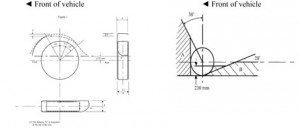Front – non triangular, 2 required at the outer edges of the front, 150mm maximum in from the edges, at least 600mm apart, at least 250mm from the ground, and 900m maximum from the ground
Rear – triangular OR non-triangular, 2 required at the outer edges of the rear. If triangular, must point up. If non-triangular, may be grouped as part of the rear lights. (so reflector in the light group? ok, that’s easy..) 400mm maximum in from the edges, at least 600mm apart, at least 250mm from the ground, 900mm maximum from the ground
Side – non–triangular, At least one on each side, within the middle third of the trailer, minimum 250mm from the ground, maximum 900mm from the ground.
Interesting, there is no specific mention of colours! Although earlier there was mention of the trailer NOT showing white to the rear, or red to the front.. So that would suggest white to the front, and red to the rear.. and yellow being the only safe colour to the side 

